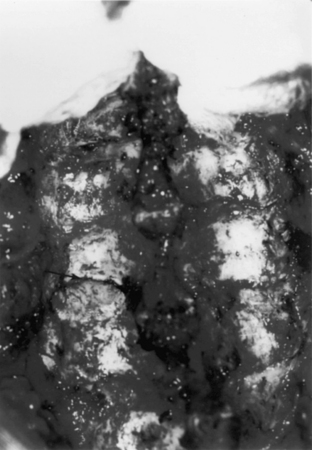Chapter 47 Interspinous, Laminar, and Facet Fusion
Basic to the details of therapeutic intervention, either operative or nonoperative, is an understanding of the biomechanical principles of cervical spine function. These considerations permit the most effective planning of a specific treatment, especially the details of surgical intervention. Generally, in the cervical region, the major mechanism of injury is transmission of force through the head. The corresponding changes are usually related to flexion, extension, or rotation, with associated axial compression or distraction. Clarification of these factors assists the surgeon in designing the most appropriate procedure. A surgeon therefore desires to counteract the major force vectors responsible for the principal injury pattern. (One would not accentuate an extension-compression or extension-distraction injury by increasing extension forces with certain posterior fixation procedures.) The selected method of treatment should be based on the biomechanics of the injury and the experience and preference of the surgeon. This chapter covers the factors predisposing to instability in the subaxial (C3-7) cervical spine and the management of instability, using wire and cable techniques. Allen et al.1 proposed a mechanistic classification based on biomechanical considerations of the injury vectors. Panjabi and White2 proposed a working classification, especially for acute instability, in which more than 3.5 mm of anterolisthesis or more than 11 degrees of angulation constitutes instability in the lower cervical spine; this classification may be helpful in evaluation. In awake patients who fail to demonstrate radiologic evidence of instability with routine cervical spine films, flexion-extension lateral radiographs should be obtained. Dynamic radiographs, however, should be approached with a level of caution. The situation is often best approached initially by CT, with sagittal reconstruction for full definition of the possible injury patterns. If instability is not demonstrated with the aforementioned studies yet is suspected from the increased prevertebral soft tissue swelling and the severe neck pain, these patients should be placed in a firm cervical collar and the flexion-extension films repeated in 2 weeks. The elapsed time allows muscle spasm to abate and allows demonstration of ligamentous instability on the flexion-extension radiographs.
Initial Management
Muscle relaxation with agents such as diazepam (Valium) assists reduction of the subluxation and alignment of the spine. Weights are added in 5-lb increments to a maximum of 35 to 40 lbs. Lateral cervical spine radiographs are obtained after each weight or position change to monitor cervical spine alignment. Patients with injuries that do not reduce on graded cervical traction, as well as those who cannot tolerate traction, are considered for early surgical reduction and stabilization. All patients with spinal cord injury with moderate to severe neurologic deficit are started on the Solu-Medrol protocol.3
Timing of Surgery
Surgery for cervical spine instability may be performed ultra early (in <6–8 hours), early (in 24–72 hours), or late (several days to weeks later). The temporal course of events may be conditioned by the presence of other associated injuries, but generally most surgeons operate on these patients between 24 and 72 hours, unless during this period there is deterioration of the patient’s neurologic status since admission. Deterioration of the neurologic status may suggest corresponding vertebral artery compromise or other events that may indicate consideration for emergent surgery. In patients with partial neurologic injury and nonreduction of the subluxation, the ongoing bony or soft tissue compression may suggest a theoretical advantage to early surgery in reducing secondary neurologic injury; the full validity of this concept has not been fully defined, however.4 In neurologically intact patients and patients with a complete neurologic deficit noted from the outset, timing is not as critical. However, early mobilization should minimize pulmonary and other complications.
Operative Techniques
Positioning, Intubation, and Monitoring
The patient is turned to the prone position, in a firm cervical collar with manual traction applied to the head ring by the surgeon. The head is supported in a cerebellar head rest, and traction is reestablished (Fig. 47-1). Mayfield skull clamps can be used if alignment can be maintained without traction. The latter mode of fixation minimizes problems with pressure necrosis of the face and potentially disastrous ocular injury. A lateral cervical spine radiograph is obtained to check alignment after turning and positioning the patient.
Exposure
Reduction of preoperatively unreduced, unilateral, or bilateral locked (“jumped”) facets should be attempted at this time. The tip of the superior facet is drilled. Using two straight curettes between the adjacent laminae in the “tire-lever” B-type maneuver and working from medially to laterally toward the facet joint, the surgeon removes the superior facet ventral to the inferior facet (Fig. 47-2). In cases in which there is a facet fracture with encroachment into the neural foramen, this fragment of bone should be removed to relieve pressure on the exiting nerve root. The surgeon should always be aware of the potential for a lateral mass fracture that mimics a unilateral facet displacement.









